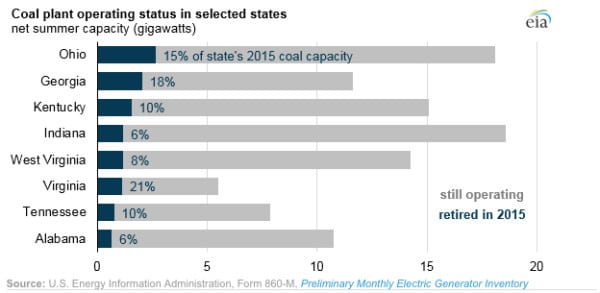EIA: 13.7 GW of Coal Capacity Was Retired in 2015
Of nearly 18 GW of U.S. generating capacity permanently shuttered in 2015, 77% was conventional steam coal–fired.
About 30% of that 13.7 GW in coal capacity was retired in April 2015, when the Environmental Protection Agency’s (EPA’s) Mercury and Air Toxics Standards (MATS) rule went into effect, said the Energy Information Administration (EIA) on March 8, citing data from the Preliminary Monthly Electric Generator Inventory. Many more coal retirements are expected next month, when plants that had received a one-year extension under MATS will need to comply with the rule.
According to the EIA, the coal units that retired in 2015 were built between 1950 and 1970, and their average age was 54 years. By comparison, the coal fleet that continues to operate has an average age of 38 years. The units retired were also much smaller on average than those that remain: “The net summer capacity of the average retired coal unit was 133 MW, compared with 278 MW for the rest of the coal units still operating,” the agency said.
Meanwhile, most of the retired coal plants were disproportionately located in three states: Ohio, Georgia, and Kentucky.
The states were among 20 that asked Supreme Court Chief Justice John Roberts to halt the rule until the EPA finishes complying with a June 2015 Supreme Court ruling that the agency did not properly consider costs in its rulemaking for MATS. On March 3, Justice Roberts rejected the plea.
According to the EIA’s data, about 8.3% of the total 17.8 GW of capacity retired over 2015 were natural gas–fired steam turbines. About 7% was from natural gas–fired combustion turbines, and about 5% was from petroleum liquids. In 2014, by comparison, 42% of all retirements were conventional steam coal–fired while 22% were natural gas steam turbines.
—Sonal Patel, associate editor (@POWERmagazine, @sonalcpatel)
